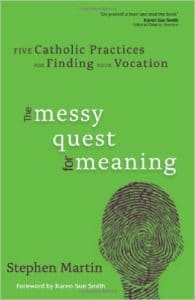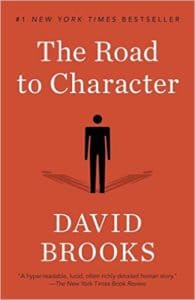In October 2018, Inscape and the Ciocca Center for Principled Entrepreneurship at Catholic University teamed up with Catholic Creatives, one of the most exciting lay movements in the Church, to hold a “hackathon”, a design challenge for Catholic creative professionals to investigate what was currently broken about the way Catholic culture thinks and talks about vocation.
We began by asking, “How can we refresh vocation recruitment to be inclusive of all vocations?”
The Problem
During the brainstorming process in meetups, we usually discover more about the problem and its consequences than we originally understood. Thus, before sharing the solutions that we found promising, we’ll begin by articulating the problems that we uncovered surrounding the way that the church talks about vocations.
First, the language surrounding vocation tends to invoke ideas about the priesthood or religious life. The vocation shortage has put a great deal of pressure on churches and dioceses to recruit. “Vocations directors,” “vocations posters,” and “prayers for vocations” at parishes, as well as vocation altar calls during retreats, are all characteristic of these recruitment efforts.
In all of these, the call to the priesthood or religious life is presented as a heroic call from God to a special and radical sacrifice for the Church. People often assume that a vocation is the call to give up one’s life for the priesthood or religious life, even if those creating such messages don’t intend that.
Whether intentionally or not, the underlying assumption that is communicated is that a vocation is a call from God to give up one’s life specifically for the priesthood and religious life. These efforts do create positive opportunities for young people to consider the religious vocation. However, the unintended consequence of these efforts is that the large majority of young people who are not called to the religious vocation come away with the impression that the call to marriage—and then to the multitude of personal vocations that the lay vocation encompasses—is not a call from God to radical holiness.
 Thus, concerning the topic of vocation, the Church is suffering from a epidemic of misunderstanding. Many deeply misunderstand the lay vocation. The lay vocation itself is deeply misunderstood, and this the lack of understanding of the lay vocation adversely effects efforts to gain more recruits for the priesthood and religious life. Religious vocations spring up when communities have a healthy culture of lay missionary discipleship. For example, the priesthood itself is a calling to love the Bride of Christ, the Church, so it follows that men would naturally be more attracted to the priesthood when the “bride,” their local parish, is thriving.
Thus, concerning the topic of vocation, the Church is suffering from a epidemic of misunderstanding. Many deeply misunderstand the lay vocation. The lay vocation itself is deeply misunderstood, and this the lack of understanding of the lay vocation adversely effects efforts to gain more recruits for the priesthood and religious life. Religious vocations spring up when communities have a healthy culture of lay missionary discipleship. For example, the priesthood itself is a calling to love the Bride of Christ, the Church, so it follows that men would naturally be more attracted to the priesthood when the “bride,” their local parish, is thriving.
Any effort that we make as a church to stimulate religious vocations cannot be done at the expense of communicating to young people the radical importance of the lay, personal vocation, or it will result in a net loss for the priesthood. In the long term, if we continue on our current course, the strong families that generate potential candidates for the priesthood and religious life will evaporate. Like overdrawing a bank account, or trying to squeeze more fruit out of an unhealthy fruit tree, our current vocational recruitment strategy involves trying to bring what we want out of what we don’t have. It’s not that the Church lacks Catholics considering religious vocations; it’s that we lack the lay vocations who are creating the strong families and communities from which religious vocations naturally arise. In short, the “vocation crisis” is a crisis of lay vocations as much as it is a crisis of priestly vocations.
 We believe that we would have much stronger families (and therefore parishes) if more young people were attracted to a heroic description of the lay vocation.
We believe that we would have much stronger families (and therefore parishes) if more young people were attracted to a heroic description of the lay vocation.
When we were speaking together at our event, we collectively realized that at crucial junctures in the discernment and growth of youth and young adults there are almost no resources to help them understand their personal vocation, or any direction to help them see how their personal vocation could fit into the greater “economy of salvation.”
We found this most evident in the transition youth experience during their Confirmation. This is often done sometime between 7th and 10th grades, just as youth are undergoing puberty and beginning to pursue passions, define themselves as individuals outside of their family units, and experience sexual awakenings. In short, this is the most crucial time for us to give young Catholics a clearer understanding of the myriad possibilities for their life, vocation, and personal holiness.
After that, the window closes. We don’t mean to speak in an alarmist tone, but we believe that, despite the strengthening of vocational recruitment efforts over the last few years, the demographic data cannot be denied: within a generation we could be in a priestly vocations free fall as more and more youth jettison their Catholicism, and fewer and fewer families produce disciples who would be good candidates for religious life.
Solutions
Catechesis is important, but the faith has always been most effectively passed on by discipleship, and a large component of a discipleship relationship is that the mentor should model for the mentee how to apply Christianity to their own specific vocation. Mentors can set an example of radical faith lived in their daily life as a plumber, designer, stay-at-home-parent, or entrepreneur. Without models or mentors to help young Catholics connect their passions with God’s purpose for the world, those passions will eventually become obstacles with which the Church must compete for their attention. When a youth is passionate about art or football or music or science (or getting married!), these passions will begin to occupy their time, attention, and schedule, and the faith will at best become a separate and secondary obligation. At worst, it becomes much, much less.
 At every juncture where youth and young adults make pivotal decisions about the passions they pursue, the Church should be there to show them how their individual passion is important, and how the faith brings more depth and meaning to that pursuit. For example, when a child chooses to play soccer competitively, they intuitively know soccer’s place in their future: they practice hard so that they can go pro, or so that they can get a scholarship to a good college, so that they can get a good job, so that they can have a wealthy and successful life. Where the Church fits into that narrative will be ancillary until they meet someone who shares their passion for soccer and who shows that their relationship with God is a vital part of that passion.
At every juncture where youth and young adults make pivotal decisions about the passions they pursue, the Church should be there to show them how their individual passion is important, and how the faith brings more depth and meaning to that pursuit. For example, when a child chooses to play soccer competitively, they intuitively know soccer’s place in their future: they practice hard so that they can go pro, or so that they can get a scholarship to a good college, so that they can get a good job, so that they can have a wealthy and successful life. Where the Church fits into that narrative will be ancillary until they meet someone who shares their passion for soccer and who shows that their relationship with God is a vital part of that passion.
From our own experiences, many of us now see that we misunderstood vocational discernment, and thought that our passions or our creative interests were in competition with our commitment to God, and that true and radical commitment to God meant sacrificing these passions or interests in exchange for higher, holier pursuits. Exalting and praying for vocations to the priesthood subtly reinforces this dualism.
Specific Ideas
Story. We can use story to model the lay vocation and its myriad expressions by discovering and publishing the stories of heroic lay and religious alike—finding modern-day saints, telling their stories, and then connecting Catholics with those stories as they discern their own personal vocation. This foundational idea was repeated over and over as a theme in all of our brainstorming groups, and was the most consistent theme of the night. The following are three different concepts that sprouted from this idea:
1) Create a website that curates the stories of missionary disciples talking about their passions for their respective personal vocation: parish priests, scientists, physicians, creatives, artists, etc., all talking about their vocation in the light of their faith. This website could then assist in linking Catholic young people with potential mentors that share their passions and interests, be used to help young people during confirmation prep, the transition from high school to college, and the transition from college into career.
2) Create an app that can be used during Confirmation classes to help youth discover their interests and charisms, then connect them with saints (and the stories of living disciples) who share those passions and gifts. This would help to link their passions to the mission of the Church during a time that often marks the end of most youth’s active participation in the Church.
3) Create featured movies telling the stories of heroic priests like Fr. Emil Kapaun (done with Mel Gibson style directing and storytelling) to help attract young men to the priesthood without the negative effects that the current strategies have on the common understanding of the lay vocation.
Things Heard at the Vocations Hackathon
The Church was once at the forefront of beauty, art and design—our mission is to do our part to bring that back! We have God-given gifts that, in a self-centered world, we can use in selfless ways for His glory.
“There is tremendous dignity in bringing beauty to the world through an artistic or creative profession,” said Luke Burgis, “but this type of work is often under-appreciated. We want to honor it, and we want to change the narrative and honor the dignity of creative professionals.”
Creativity is a broad term, and our community events often have a range of people from engineers to filmmakers to software developers to lawyers. Anyone who would like to see Catholicism become a leader in culture, and is willing to engage creatively with others. Anyone who has said, “why do we do this this way?” and then felt like they never had a place to really ask that question more deeply.
“Creativity is an essential part of entrepreneurship, and creativity for a Catholic entrepreneur means creating things that are true, good, and beautiful. Catholic Creatives embodies this kind of entrepreneurship–the mission of the organization is to bring the gospel to the world in fresh, beautiful ways.”




